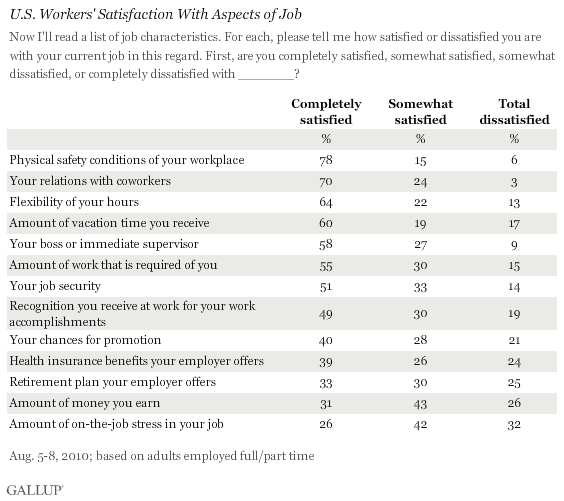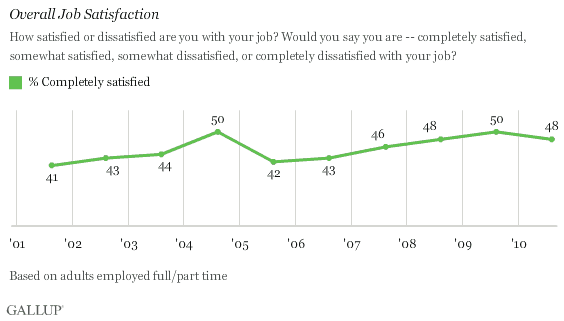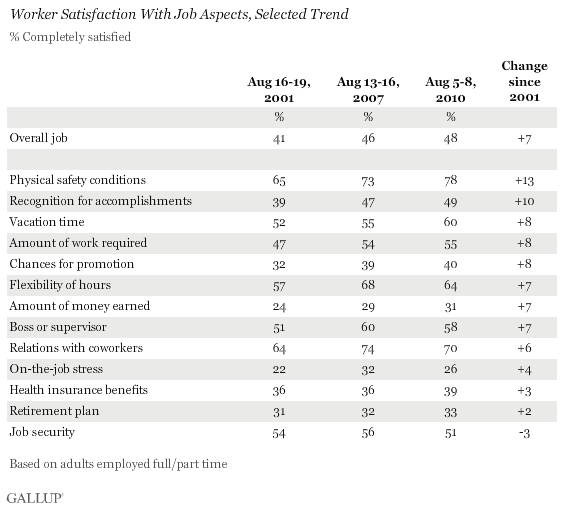PRINCETON, NJ -- The majority of U.S. workers are completely satisfied with several aspects of their work environment, including their relations with coworkers, the flexibility of their hours, and the amount of work required of them. Of 13 job characteristics rated, they are the least satisfied with their on-the-job stress, followed by their pay.

No more than 32% of workers are dissatisfied with any of the job aspects rated in the Aug. 5-8 Gallup poll; however, the number completely satisfied does dwindle well below 50% for several. Aside from stress, these include the important material rewards that come from working: pay, company retirement plans, health insurance benefits, and one's opportunity for promotion.
Worker Satisfaction Higher Than Decade Ago
Worker satisfaction ratings have not changed appreciably over the past year, or even since August 2007, a full year before the start of the global financial crisis. However, workers do appear to be more satisfied today than they were at the beginning of the decade, when Gallup launched the annual measure.
This is seen in the trend for overall job satisfaction, in which 48% are now completely satisfied, similar to the 50% recorded last year, but higher than 39% to 43% readings in most years from 2001 through 2006.

Workers also appear to be more satisfied today than in 2001 with several specific aspects of their jobs. Ratings for physical safety at work, recognition for work accomplishments, the amount of work required, vacation time, and chances for promotion all show significant improvement since 2001.
Over the same period, workers have become no more satisfied today with their job security, their companies' retirement plans or health insurance benefits, or on-the-job stress.

Bottom Line
Despite severe turbulence in the U.S. economy and labor market in recent years, working Americans' satisfaction with their job conditions has changed little since 2007. The long-term comparison is more mixed. Workers are more satisfied today than they were in 2001 with the amount of work required of them, the recognition they receive, their chances for promotion, and pay, among others. Thus, either employers have become more generous in these areas, or employees -- perhaps more grateful to have a job -- have become easier to please. At the same time, there has been little or no improvement in worker satisfaction in three important areas: health insurance benefits, retirement plans, and job security.
Stress has consistently ranked near the bottom in Gallup's annual worker satisfaction ratings, trading off with pay for last place. The potentially good news offsetting this is that workers continue to be largely content with their bosses, and with their coworker relations.
Survey Methods
Results for this Gallup poll are based on telephone interviews conducted Aug. 5-8, 2010, with a random sample of 1,013 adults, aged 18 and older, living in the continental U.S., selected using random-digit-dial sampling.
For results based on the total sample of 499 adults employed full time or part time, one can say with 95% confidence that the maximum margin of sampling error is ±5 percentage points.
Interviews are conducted with respondents on landline telephones (for respondents with a landline telephone) and cellular phones (for respondents who are cell phone-only). Each sample includes a minimum quota of 150 cell phone-only respondents and 850 landline respondents, with additional minimum quotas among landline respondents for gender within region. Landline respondents are chosen at random within each household on the basis of which member had the most recent birthday.
Samples are weighted by gender, age, race, education, region, and phone lines. Demographic weighting targets are based on the March 2009 Current Population Survey figures for the aged 18 and older non-institutionalized population living in continental U.S. telephone households. All reported margins of sampling error include the computed design effects for weighting and sample design.
In addition to sampling error, question wording and practical difficulties in conducting surveys can introduce error or bias into the findings of public opinion polls.
View methodology, full question results, and trend data.
For more details on Gallup's polling methodology, visit https://www.gallup.com/.
